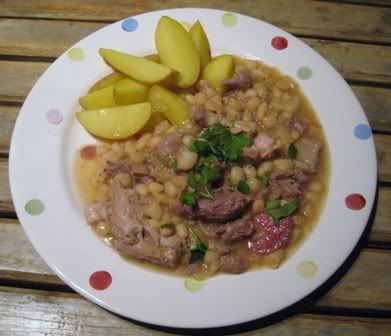3 tablespoons oil (light olive, or vegetable) 2 large onions
4 cloves garlic
1kg lean beef mince
200ml red wine
3 tins chopped plum tomatoes
1 tablespoon dried oregano
3 tablespoons tomato puree
1 tablespoon tomato ketchup
900ml white sauce (see recipe)
Salt and pepper
300g grated hard pale cheese (cheddar is fine)
2 boxes dried lasagne sheets
200g grated parmesan
Place a very large pan on the hob, over a low heat. Finely chop the onion and garlic, and fry gently in the oil until glossy but not brown. Add the mince, and continue to fry gently until all the meat is grey (about 10 minutes), stirring occasionally.
Turn up the heat to high, and add the red wine. Boil rapidly for 2 minutes, to reduce the liquid in the bottom of the pan by about half. Add the tinned tomatoes, oregano, tomato puree and ketchup. Stir, bring to the boil, and add a good twist of salt and pepper. Turn the heat down to low, cover, and leave to simmer gently for 20 minutes.
Pre-heat the oven to 160C.
Make a ‘triple mix’ of white sauce (see recipe) and add the grated cheddar to it. Stir, and allow the cheese to melt.
Check the mince filling for seasoning, and add more salt and pepper if necessary.
To assemble the lasagne – take a very large, rectangular, ovenproof dish. Mine is as large as I can get in my oven – 35x25x5cm. You may need two or even three smaller dishes, if you don’t have a huge one. Put a third of the mince filling in the bottom of the dish(es). Add a single layer of lasagne. Repeat another twice, finishing with pasta on the top. Pour over the cheese sauce, easing it down through the gaps in the pasta with a knife. Try to get it all in. ‘Plump up’ the lasagne, to expel air, and add some more sauce. Lift the corners, and sneak in a little more.
Cover the dish(es) with foil, and place in the oven for 1 hour. Remove from the oven.
*Sprinkle the grated parmesan over the lasagne, and return it to the oven (uncovered) at 200C for 15 minutes (or 180C for 30 minutes, if it’s cold when it goes back in for its second cooking time).
*Note: Lasagne needs to be cooked twice, to be perfect, so it’s better if you can allow it to cool completely (or even put it aside overnight) before its second cooking. If you put it straight back in the oven, it will end up a little runny. If you let it cool then re-bake it, it will be drier and the flavours will have matured. Italians always bake their lasagne twice, the second time is often in the pizza oven, in single portions. An Italian friend (and great cook) told me that good lasagne should be “like blankets on a bed, not newspapers in a puddle”.








